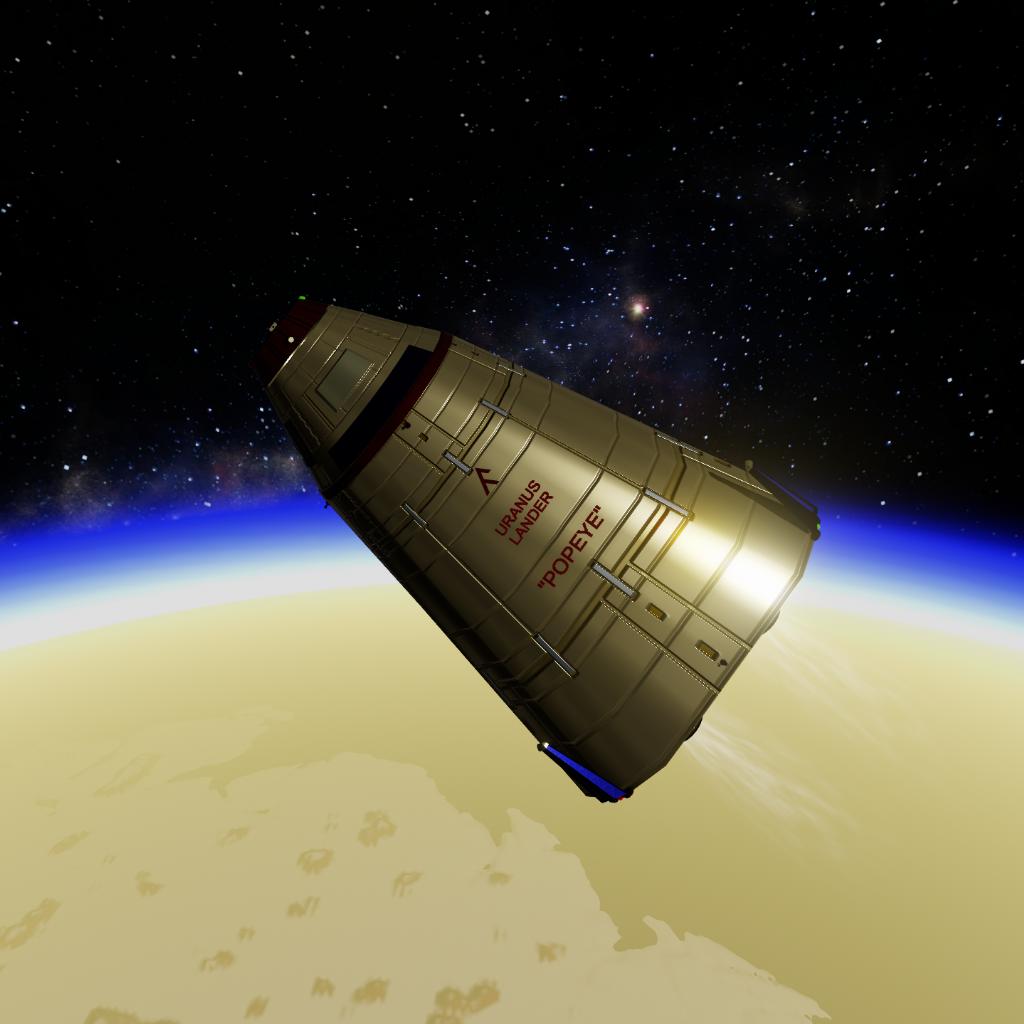Slider 1: Pans camera
Slider 2: Zooms pan and landing cameras
To replicate color scheme, set Europa Detail, Solar Cell, and Brushed Heavy Metal (gold, dark blue, dark red) to 75% smoothness, 90% metallic
Announcing the public availability and testing of the Urados Roundtrip Access Next-generation Unity System (URANUS) Phase 2.2! URANUS is a fully non-tinkered system for sending a crewed mission to Urados and back.
Phase 2 - codename "Popeye" - is a fully reusable Manned Orbital-transfer Module (MOM) capable of landing a mission crew of 2 on any of the moons of Urados including Taurus, and returning them to an Orbiter around Urados.
Features (Phase 2.1)
- Fully Career compatible (no tinkering)
- Fully reusable - dock with an Orbiter to refuel/recharge, and go out on another mission
- 6000 m/s vacuum delta-V minimum (~2500 vacuum delta-V when on missions to Taurus)
- 20t wet mass, 15t propellant mass maximum
- Rated for 3 personnel, nominal crew of 2
Upgrades for Phase 2.2:
- Taurus Outboard Methane Atmosphere Take-Off (TOMATO) unit
- Descent Atmospheric Device (DAD)
- Computer-assisted ascent/descent protocols for all moons of Urados (AG 3/4)
(See comments for additional technical notes)
URANUS Roadmap:
- Phase 1 (80%) - benchmark roundtrip transit time and delta-V requirements to Urados
- Phase 2 (Phase 2.2 90%) - develop Manned Orbital-transfer Module and Descent Atmospheric Device (MOM and DAD)
- Phase 3 (20%) - develop Urados Orbiter and Crew Return Vehicle
- Phase 4 (notional) - develop Outbound Transit Vehicle
- Phase 5 (notional) - develop launch systems to low Droo orbit and orbital assembly and fueling infrastructure
- Phase 6 (notional) - execute manned mission to Urados
GENERAL INFO
- Predecessor: "Popeye" - URANUS Phase 2.1
- Created On: Windows
- Game Version: 1.0.909.1
- Price: $3,300k
- Number of Parts: 51
- Dimensions: 9 m x 5 m x 5 m
PERFORMANCE
- Total Delta V: 5.8km/s
- Total Thrust: 137kN
- Engines: 10
- Wet Mass: 19,853kg
- Dry Mass: 5,128kg
STAGES
| Stage | Engines | Delta V | Thrust | Burn | Mass |
|---|---|---|---|---|---|
| 1 | 8 | 5.8km/s | 137kN | 7.7m | 19,853kg |










There are some technical limitations to a non-tinkered, fully reusable, go everywhere and do anything lander.
- If using on a mission to Taurus, it only has about 2500 m/s delta-V for all vacuum operations. Taurus is very expensive fuel-wise to take off from. In practical terms, if you land with less than ~70% fuel, you run the risk of not having enough fuel to rendezvous with your Orbiter. Also, Taurus ascent is VERY SLOW. The program is not broken, this is normal. Please be patient, it will get you into orbit, I promise.
Some additional technical notes:
- The DAD parachute is slightly offset from center. This was necessary so it wouldn't get buried under the docking port and become impossible to click/reset, and also the parachute collider made it a real B to get docked. There's no way to repack a parachute automatically - turning it off just sets it to "cut." You have to manual repack after each use.
- Use aerobraking at Taurus to save fuel - you may need to aerobrake more than once if coming in very fast. To save weight, there's no heat shielding. If aerobraking >1200 m/s, try aiming for a periapsis of 70km, this should be high enough not to burn up. If coming in faster than 1600 m/s you might have to do a retro burn after the first aerobrake to prevent bouncing back out to Urados.
- Main Engine cutover on Taurus is at 7.5 kPa, or about 24000 ASL. Above this, use Main Engines; below, use Ascent Engines
- To simplify sequencing, everything is staged at the same time, and controlled by AGs. By default, when you are docked, the Command Module will secure engines and auxiliaries and turn itself off so it doesn't fight your Orbiter's control systems. When you undock, turn the Command Module on, and it will automatically stage and initialize engines to the "off" position.
- The circularization burn window for Jastrus is so short that it's possible to time warp straight through it without triggering the slowdown to Normal time
- Inclined orbits can have the prograde vector point differently from the ship's head. The program won't correct this to give you the freedom to set your own heading
-Ascent/Descent programs can be canceled and resumed at any time. Descent program will only engage below 80,000m and on an impact trajectory.